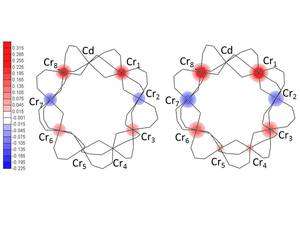Neutrons used to directly observe the behaviour of tiny magnetic 'chains'

Conventional electronic devices all have one thing in common – they rely on the transport of electrons in semiconductor materials like silicon. But tomorrow's spintronic devices could look totally different. Spintronics is a shortened term meaning "spin transport electronics", because rather than exploiting the charge of an electron, they use a property called spin, to store and transmit data. Every electron spin is oriented, in a field, in one of only two directions – up or down – but the orientation can be manipulated by both magnetic and electric fields.
Once the reserve of theorists, finite spin chains, which are arrays of a small number of interacting magnetic ions, have become the subject of an intense research effort, thanks to their potential use for quantum information technology. Since they can be engineered into different lengths with particular spin structure properties, they could be the key to making spintronic devices a reality. The challenge, however, has always been to directly measure the magnetic moments of finite spin chains. Microscope techniques such as spin-polarized scanning tunnelling microscopy (SP-STM) do not yet offer sufficiently high sensitivity for accurate quantitative measurements.
So researchers turned to the ILL's D3 and D19 neutron diffractometers and their results were reported in a recent issue of Nature Communications. Now, for the first time, the magnetic moment on each ion in a finite antiferromagnetic chain has been quantitatively measured, marking a breakthrough for experimental spintronics. According to lead author Tatiana Guidi, "In future information technology, we want to go ever smaller. Finite spin chains represent the smallest level on which we can exploit magnetic materials for quantum communication."
These building blocks of spintronics weren't without their surprises though; Guidi and her colleagues found that the length of the chain (the number of magnetic ions) had a huge impact on the alignment of the spins. Changing the number of ions in the chain – even adding a single extra ion – completely changed the behaviour of the spins. For example, under a magnetic field, odd-numbered chains aligned their spins with the field. But even-numbered chains aligned themselves very differently - in a non-collinear pattern with respect to the field direction. According to Guidi, "This is the first direct and quantitative data on the spin arrangement of such small structures, and it gives fundamental information about their behaviour in a magnetic field which could be exploited for spin manipulation and transport in quantum devices."
More information: "Direct observation of finite size effects in chains of antiferromagnetically coupled spins." Nature Communications 6, Article number: 7061 DOI: 10.1038/ncomms8061
Journal information: Nature Communications
Provided by Institut Laue-Langevin



















